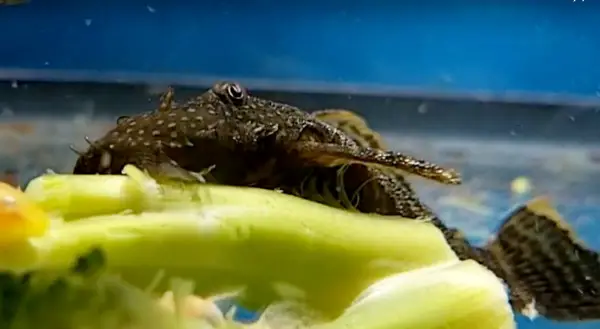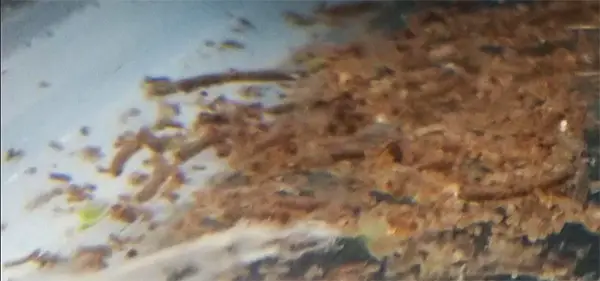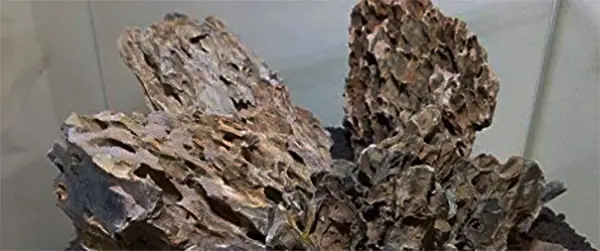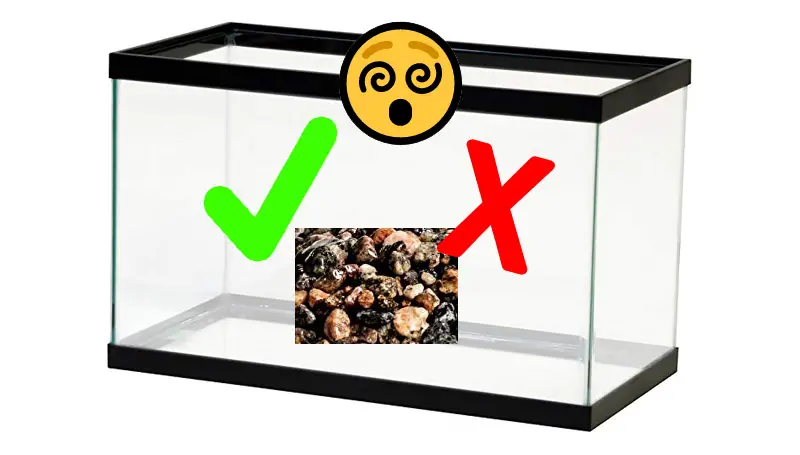Bare bottom fish tanks, let’s think about the pros and cons!
If you’re new to the fishkeeping hobby, you probably imagine a fish tank with a layer of gravel along the bottom. A substrate of small rocks like that is quite prevalent among casual aquarium owners. However, you might have been into a fish store with and seen that the tanks have no gravel!
So, now you might be wondering: what are the pros and cons of bare bottom fish tanks?
Bare Bottom Fish Tanks: Substrate & Bacteria
If you have a gravel substrate, it will be absolutely teeming with bacteria! Before you panic and think that’s a bad thing, let me remind you that bacteria in your aquarium is a good thing. Beneficial bacteria colonize all surfaces in your aquarium; that bacteria will then consume ammonia and convert to nitrite and, ultimately, less harmful nitrate.

However, sometimes the bacteria cannot keep up with the fish waste. This is especially the case if you do not gravel vac and clean up your gravel substrate. Gravel and sand make it difficult to siphon off fish poop and any uneaten food.
So, when it comes to cleanliness, a substrate has the pro that it adds to the beneficial bacteria colony in your aquarium. While, it also has the con of being a magnet for excessive detritus.
Growing Plants In A Bare Bottom Aquarium
Some plants must be rooted in the substrate. So, without a substrate, you either won’t be able to grow them or you’ll need to add plant pots with substrate to grow them in.
However, some plants don’t require substrate to grow in.
First of all, there are floating plants that either float in the upper column of the water or, alternatively, they grow on the surface of the water. Hornwort is a good example of the former, while Amazon frogbit is a good example of the later.

In addition to floating plants, there are also rhizome based plants like anubias and java fern that grow horizontally along surfaces. In fact, if you plant those type of plants into your substrate it will kill them.
Bare Bottom Tanks Make Some Fish Nervous
A lot of fish don’t care about a bare bottom. For example, I’m staring into my bare bottom tank full of bristlenose fry and they couldn’t give two hoots that the bottom of the tank is just bare glass.

However, it can really spook some fish. For example, I wouldn’t recommend keeping timid fish—e.g. wild caught silver dollars—in a bare bottom tank. In nature fish are used to below being dark and above being bright. If all of a sudden light is reflected from the bottom then it can make them nervous.
The Role Of Filtration In Bare Bottom Tanks
If you have a bare bottom aquarium, then be aware that your filtration must have a high quality filter media with a large surface area. This is because your beneficial bacteria will need somewhere to live, if it can’t live in a bed of substrate.
Bare Bottom Aquariums Can Be Ugly
It goes without saying that a bare bottom aquarium might not be aesthetically appealing.
However, there’s more to the ugliness of a bare bottom aquarium than just the reflective glass itself. This is because the second a fish poops, that poop just lands on the glass and it just sits there. The poop sits there in all its gross glory.

Whereas, in an aquarium with a gravel bottom the poop is at first camouflaged against the earth tones of the stones. And then, ultimately, it gets buried in the gravel until you decide to vacuum the gravel.
Bare Bottom Fish Tanks Don’t Have To Be Ugly Though
People assume that a bare bottom aquarium can’t have a nice aquascape and that simply is not the truth. Sure, ultimately, a setup with a natural looking substrate is always going to have a head start.
But, that doesn’t mean you should give up!

I recommend focusing your bare bottom aquascape around a centerpiece such as a formation of large rocks or, perhaps, an interesting piece of driftwood (bog wood).
After setting up the hardscape (rocks, wood, etc), next you need to pick some plants. Because they don’t need a substrate to grow, I like rhizome based plants like java fern or anubias.

These plants can be tied to the rock/wood, or you can actually glue them to it using super glue (cyanoacrylate glues are aquarium safe). In a matter of weeks, your plants will begin to root over the wood or rocks and secure themselves naturally.
Conclusion
The core benefits and drawbacks of having a bare bottom aquarium focus around maintenance issues. If you’re not inclined to siphon and gravel vac your substrate, then maybe you should go with a bare bottom tank. Whereas, if your aquarium is going to be a display tank in your living room, then you might need a bed of gravel for aesthetic reasons.
It really comes down to personal choice; bare bottom and a layer of substrate are both perfectly fine!


